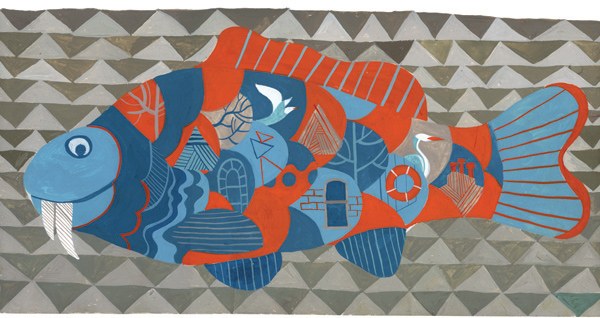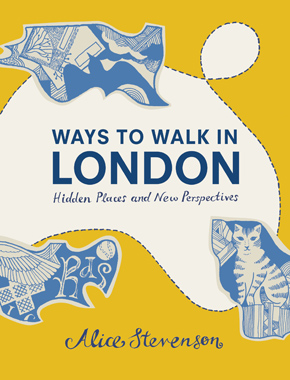Alice Stevenson: Look around you
by Mark ReynoldsArtist Alice Stevenson has spent many years exploring all corners of London on foot, observing hidden delights and finding inspiration in unlikely places. Ways to Walk in London is her enchanting tribute to the city, combining sparkling insights and gorgeous illustrations to capture places and moments of beauty, contemplation and wonder. I discover what motivates her to get out the door.
What are your favourite London walks?
I love the walk from Chiswick Bridge to Richmond via Strand on the Green and also from Teddington Lock to Richmond. I find these routes very comforting and infused with happy memories as I grew up in Chiswick, plus they feature eyots (river islands) and beautiful wildlife and greenery.
Apart from walking set paths along rivers or canals, I don’t have defined favourite walks, more areas to walk in. I like to vary my route each time. My current favourite is from New Cross to Telegraph Hill, Brockley and Nunhead. Its hilliness means that just walking a square mile radius gives you dramatic views of London whilst remaining nestled in residential Victorian streets.
Does your choice of walk depend on your mood?
If I’m feeling fragile I’m probably more inclined to select a route that involves water, open space or good views as these have a restorative effect. I would be less inclined to walk somewhere busy and bustling.
How far do you walk in a typical day?
It really varies depending on what I’m doing but I would say between three and five miles is fairly standard.
 Ways to Walk in London” width=”240″ height=”270″>What keeps you from walking?
Ways to Walk in London” width=”240″ height=”270″>What keeps you from walking?
Recently I sprained my ankle so I had to avoid walking as much as possible, something I found very frustrating. Apart from that, nothing really except perhaps torrential rain – even though a rainy walk can be very liberating it’s not always practical to turn up at things completely drenched.
What items do you always carry on a London walk?
My iPhone so I can take photos and listen to music should I feel inclined, a notebook, a pen and a bottle of water. A tangerine is a good fruit for energy replenishment.
What’s the most surprising thing you’ve discovered right on your doorstep?
St Thomas’s graveyard just of Mare St in Hackney, I had walked past its entrance every day on my way to my studio without giving it a second glance. When I finally explored it, I was delighted to discover a peaceful and enchanting walled garden and graveyard right in one of the most built-up and charmless parts of Hackney.
How often do you walk at night?
I love walking at night and I do it a lot largely just to get from A to B. I enjoy taking a scenic route to my destination or having a little explore on my way home if I’ve been out. I know it’s not entirely safe to do alone, especially as a woman, and this makes me sad and rather angry as walking at night is one of the most fascinating ways to explore a city.
 Ways to Walk in London” width=”290″ height=”210″>Which other cities do you love to walk in and why?
Ways to Walk in London” width=”290″ height=”210″>Which other cities do you love to walk in and why?
I love walking in Berlin, it’s so layered and contradictory in terms of history and architecture. It’s both extremely beautiful and ugly at the same time and also peaceful, a very exhilarating combination. I love walking in San Francisco too, for very different reasons. The hilliness provides breathtaking views at every corner and the pastel-coloured timber houses with gardens featuring spectacular trees and succulents are just delightful. The fog adds an extra dimension of strangeness to the experience.
What is the longest walk you’ve been on?
I’ve been on some 30-mile treks in mountainous areas but in terms of city walking, I have walked from East or North London back to Chiswick in the early hours after nights out in my youth.
And the most spectacular?
It’s impossible to identify which walk has been the most spectacular as I’ve found so many walks I’ve been on awe-inspiring in completely different ways. Perhaps when I first ascended a hill in the Castro area of San Francisco and witnessed the incredible beauty of the city for the first time. Or recently I spent a weekend in Lisbon – at every other turn we were met with remarkable views, especially climbing up to the castle in Alfama and at the summit of every hill in Bairro Alte where we stayed.
 Ways to Walk in London” width=”310″ height=”164″>How much of your drawing is inspired by nature, and what are the recurring themes?
Ways to Walk in London” width=”310″ height=”164″>How much of your drawing is inspired by nature, and what are the recurring themes?
I find the patterns and shapes of natural forms inspiring and consciously or subconsciously this always is present in my drawing. Yet I find immense beauty in manmade forms, in particular buildings and decorative arts. As a freelance illustrator, I have tackled a vast range of subject matter within my work, however a fascination with the atmosphere of a place and with exploring hidden details are the overarching themes of my visual output.
Which artists have inspired you and how?
I’m deeply inspired by Eric Ravilious, in particular his watercolour landscapes. I find the way he uses light to create images that are both graphic yet delicate and haunting utterly mesmerising. Paul Klee is another of my favourite artists, I find the playful and intricate detail of his lines so pleasing. Tove Jansson is a hero of mine, both as a writer and an artist, the Moomin illustrations and stories are so charming yet spooky, strange and atmospheric. I adore the hyper-real colour palette landscapes of illustrator Brian Cook.
What are your favourite working materials?
Pen and ink, fineliner, gouache and watercolour. I also love the alchemy and line quality of etching. I’m about to embark on a lithography course, which I am extremely excited about.
What other kinds of art do you practice?
I work as a commercial illustrator creating book covers, packaging and editorial illustrations for all manner of clients. I also paint and create etchings and screen prints.
Which other books about walking would you recommend?
My great favourites are A Field Guide to Getting Lost which is a collection of essays by Rebecca Solnit. I found her essay ‘The Blue of Distance’ revelatory as she articulated what I’d always felt about landscape but had never been able to put into words. The Wild Places by Robert McFarlane inspired me to stop, look and see the wonder in my surroundings. The Song Lines by Bruce Chatwin, whilst being a beautiful travelogue, also introduced me to the incredible Aboriginal Song Line system. A whole culture where land is experienced in terms of specific paths interspersed with sacred landmarks, as opposed to being divvied up into territories. It’s utterly mind-blowing stuff and transformed the way I view the act of walking.
Ways to Walk in London” width=”600″ height=”198″>
 Ways to Walk in London” width=”224″ height=”193″>Alice Stevenson lives in southeast London and is an artist, surface pattern designer and educator. She has created designs for Crabtree & Evelyn, Kellog’s, the University of Sussex, Volvo, Vodafone, Marc by Marc Jacobs, Vogue, Hugo Boss and numerous publishers. Ways to Walk in London is published by September Publishing. Read more.
Ways to Walk in London” width=”224″ height=”193″>Alice Stevenson lives in southeast London and is an artist, surface pattern designer and educator. She has created designs for Crabtree & Evelyn, Kellog’s, the University of Sussex, Volvo, Vodafone, Marc by Marc Jacobs, Vogue, Hugo Boss and numerous publishers. Ways to Walk in London is published by September Publishing. Read more.
alicestevenson.com
Mark Reynolds is a freelance editor and writer, and a founding editor of Bookanista.


